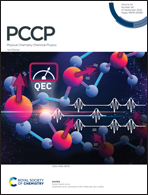Computational investigation of van der Waals corrections in the adsorption properties of molecules on the Cu(111) surface†
Abstract
Here, we report a computational investigation on the role of the most common van der Waals (vdW) corrections (D2, D3, D3(BJ), TS, TS+SCS, TS+HI, and dDsC) employed in density functional theory (DFT) calculations within local and semilocal exchange–correlation functionals to improve the description of the interaction between molecular species and solid surfaces. For this, we selected several molecular model systems, namely, the adsorption of small molecules (CH3, CH4, CO, CO2, H2O, and OH) on the close-packed Cu(111) surface, which bind via chemisorption or physisorption mechanisms. As expected, we found that the addition of the vdW corrections enhances the energetic stability of the Cu bulk in the face-centered cubic structure, which contributes to increasing the magnitude of the mechanical properties (elastic constants, bulk, Young, and shear modulus). Except for the TS+SCS correction, all vdW corrections substantially increase the surface energy, while the work function changes by about 0.05 eV (largest change). However, we found substantial differences among the vdW corrections when comparing its effects on interlayer spacing relaxations. Based on bulk and surface results, we selected only the D3 and dDsC vdW corrections for the study of the adsorption properties of the selected molecules on the Cu(111) surface. Overall, the addition of these vdW corrections has a greater effect on weakly interacting systems (CH4, CO2, H2O), while the chemisorption systems (CH3, CO, OH) are less affected.



 Please wait while we load your content...
Please wait while we load your content...